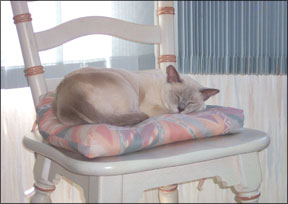When a cat is not doing well, for whatever reason, she depends upon her special person to take notice. Usually, some behavioral change will be observed. The behavioral change is the clinical sign that drives a person to consult with his veterinarian. Bev Caldwell 288 Veterinarians receive complaints ranging from the very specific “My cat is sneezing” to the very elusive “My cat is just not herself.” These behavioral changes are the indicators that a cat needs attention. Regardless of the nature of the reported clinical signs, a workup will be done so that a diagnosis can be established. Veterinarians require a diagnosis, or at least a therapeutic plan, in order to successfully treat their patients. It is tempting to use the clinical sign itself as the diagnosis. But clinical signs and behavior changes are just signs. Consider the sneezing cat. Many conditions cause the behavioral sign of sneezing: allergies, foreign bodies in the nose and even tumors are only some of the underlying conditions that must be ruled out before the final diagnosis is determined. Each of these conditions would require a very different treatment strategy. A veterinarian must combine the history that you provide along with her own physical findings and laboratory test results to finalize a diagnosis and begin appropriate treatment. What Behavioral Changes Mean Many of the behavioral changes that bring cats to the veterinarian actually have an organic basis. That is to say, the veterinarian will be able to discover an underlying medical condition that caused the problem. We expect our veterinarian to tell us why our cat is limping, or not eating. Yet sometimes, the diagnostic protocol is overlooked when it comes to the behavioral sign of urinating outside the litter box. The frustration of cleaning urine spots drives many people to simply label the cat as behaving badly. A workup is needed to be sure that the soiling cat is not suffering from an underlying medical condition. An uncomfortable infection or inflammation in the urinary tract may be responsible for this frustrating behavior change. Once the physical examination and lab work reveal that the cat is indeed healthy, the workup must still continue. Remember, urination out of the box is a clinical sign, not a diagnosis. It is a behavior change that – no different from sneezing – can have many causes. Your veterinarian must determine the diagnosis so that the appropriate treatment strategy may be determined. A very careful and detailed behavioral history will be needed. Be prepared to answer a lot of questions, as there are many behavioral conditions to consider. A very common reason for a cat to urinate outside her box is that the box is just not accessible to the cat. There may be physical impediments: perhaps the cat has arthritis and can no longer comfortably climb the steps to the box. There may be behavioral barriers as well. For example, not all cats are willing to pass through a noisy playroom to reach their boxes. Your veterinarian will need to know where the litter box is located. Photos are invaluable. Sometimes, a cat can get to her box but is just not willing to use it. Perhaps the box is not clean enough for your meticulous cat – be frank with your veterinarian about the hygiene regimen you follow. Since all cats do not like all litter types, consider the type of litter you use as well as any recent changes in litter type. Even a change in brand may be enough to send a cat seeking a new toilet. If your history offers support that a litter box has become unavailable or unacceptable, your veterinarian may diagnose inappropriate urination due to an aversion to a litter box, to a location or to a substrate. Other potential diagnoses include location preference and substrate preference. Once properly diagnosed, these conditions are usually very treatable. An entirely different set of diagnoses will be considered if your behavioral history suggests that your cat has begun to urinate outside her box in an attempt to express anxiety or aggression. Urine marking serves an important communication function among cats. And surely our cats must assume that we humans are quite capable of reading these important messages. Urine marking is also quite treatable. Social issues will be addressed so that anxiety and aggression can be reduced to a comfortable level. Behavior modification and, in some cases, anxiety-reducing medication may be prescribed to complete the treatment plan. Working up a behavioral condition is no different from working up a medical problem. History-taking and behavioral testing can be time consuming. But this initial expense in time will assure that your cat is treated for the correct condition. 



